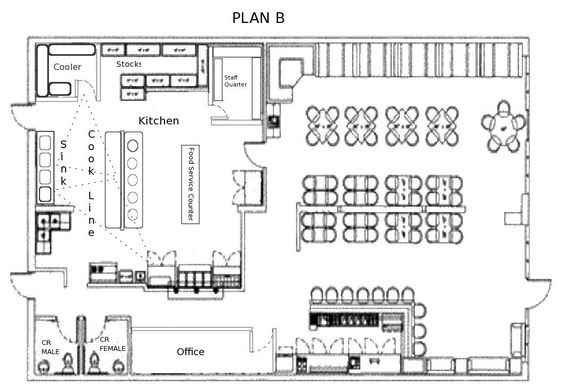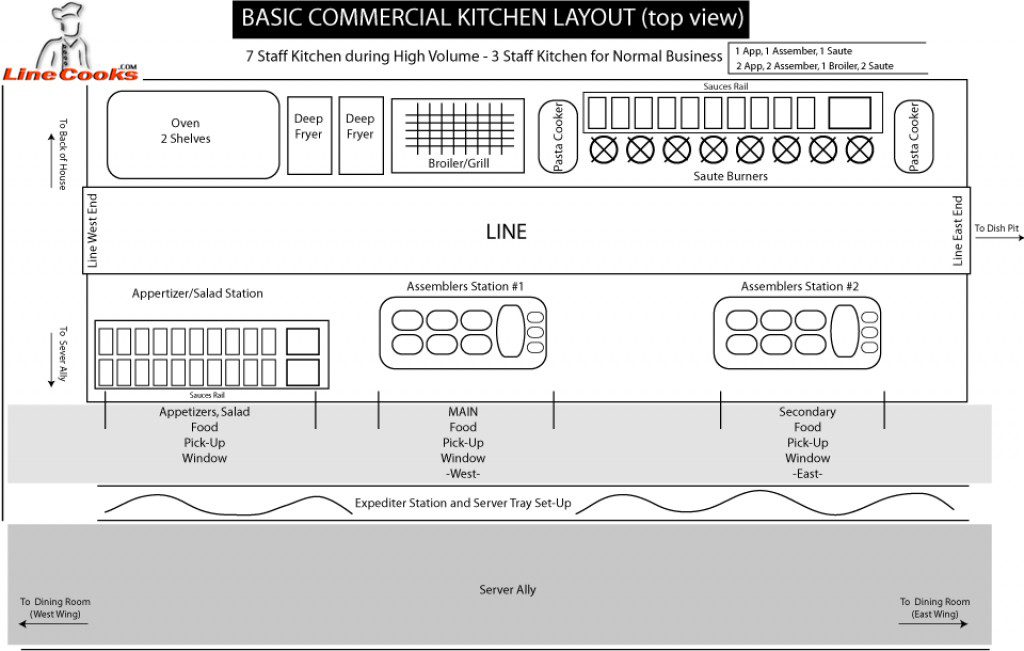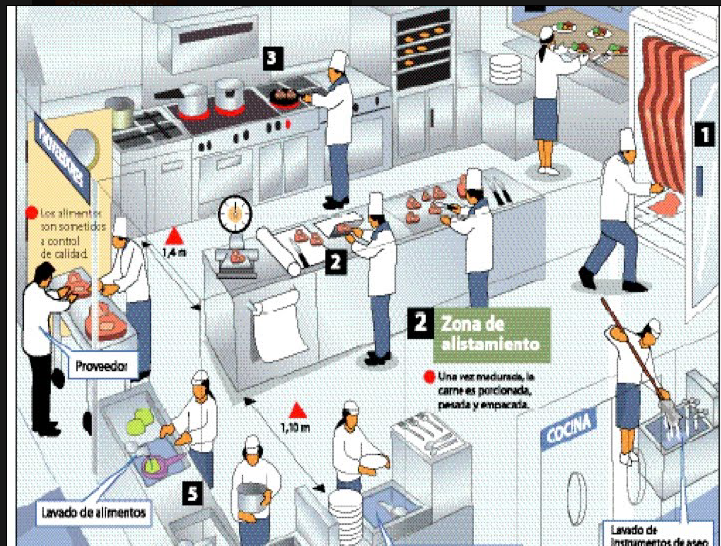Components of a Commercial Kitchen
Most people hear “commercial kitchen” and think of ranges, grills, fryers, and maybe a frantic, angry chef yelling out orders. That may be the case, but the true commercial kitchen is much more than just the equipment or personnel found in it. A successful kitchen includes specific components organized in a particular pattern to optimize performance and efficiency. Those components are:
- Cleaning/washing
- Storage
- Food Preparation
- Meal Cooking
- Service
Cleaning/Washing
The cleaning and washing section of a commercial kitchen includes sinks, warewashing machines, and drying racks. This section is first on the list because without dirty dishes there are no clean dishes to serve your food on. Three-compartment sinks are necessary for washing utensils, while warewashing machines can quickly clean plates and other serving vessels to keep the kitchen running at full speed. This section of the kitchen should be located near the kitchen entrance so servers can quickly drop off dirty dishes, and near the storage area so chefs can quickly find clean dishes.
Storage
The storage area can be split into non-food storage, cold storage, and dry storage. The non-food storage area can be split further into a section for disposable products, a section for cleaning supplies, and a section for the clean dishes from your cleaning/washing area. Remember, in order to avoid contamination, cleaning and sanitation chemicals cannot be stored above food, food equipment, utensils, dishes, or disposables like cups and plastic cutlery. Cold storage is where you keep anything that needs to be refrigerated or frozen, while dry storage includes all nonperishables and other consumables. This area might also contain a receiving area for inventory shipments, shortening the distance new stock has to travel through your restaurant.
Food Preparation
The food preparation area has sinks for washing produce, cutting areas, and mixing areas. Typically, the food preparation area is split into a section for processing raw foods (breaking down cuts of beef, for example) and a section for sorting foods into batches (chopping vegetables, mixing salad dressings, etc.). Placing this section near your storage area allows cooks to efficiently grab fresh dishes, prepare plates, and move them on to the cooking area quickly.
Meal Cooking
The meal cooking area makes the rest of the kitchen tick. This is where main dishes are finished, so here you will have ranges, ovens, exhaust hoods, fryers, griddles, and other cooking equipment. Like the food preparation area, the meal cooking area can be broken down into smaller sections like a baking station, grilling station, and frying station. Because meals are finished here, the meal cooking area should be near the front of the kitchen next to the service area.
Service
The service area is the final section of a commercial kitchen. If you have a serving staff, this is where they will pick up finished dishes to take to customers. If you have a self-serve or buffet-style restaurant, this is where foods will be displayed in warmers for customers to assemble their plates. This area needs to be located at the very front of the kitchen, just after the meal cooking area, to shorten the time and distance between completed meals and customers.
Commercial Kitchen Design Layouts
There is no perfect formula for commercial kitchen layout. Every foodservice establishment is unique and will operate differently than others, so you have to decide what will help you best meet your kitchen goals. That said, there are several basic commercial kitchen design layouts to consider that succeed in blending solid kitchen design principles and kitchen components effectively.
Island-Style Layout
The island-style layout places the ovens, ranges, fryers, grills, and other principle cooking equipment together in one module at the center of the kitchen, while other sections of the kitchen are placed on the perimeter walls in the proper order to preserve a circular flow (any section can be the “island” depending on what best suits your needs). This layout is very open and promotes communication and supervision, while leaving plenty of open floor space for easy cleaning. This layout works best in a large kitchen that is square in shape, but can certainly be modified to fit other shapes and sizes.
Zone-Style Layout
The zone-style layout has the kitchen set up in blocks with the major equipment located along the walls. Again, the sections follow the proper order for increased flow, giving you a dishwashing block, a storage block, a food prep block, etc. Communication and supervision are not difficult in this layout because the center of the space is completely open.
Assembly Line Layout
The assembly-line configuration is ideal for kitchens that need to serve a large quantity of people quickly, like cafeterias or correctional facilities. This layout may work better for establishments with a limited menu that serve large quantities of the same foods, like a sandwich or pizza shop, but it is viable for any type of kitchen. In this layout, kitchen equipment is organized in a line with the food preparation area at one end and the service area at the other, allowing cooks to quickly send food down the line. The cleaning/washing and storage/receiving areas can be located behind the assembly line to keep them out of the way. This creates supreme efficiency, and keeps the kitchen open for excellent communication and flow. Often, kitchen equipment can be linked together, further eliminating wasted space.
Good Planning Practices
Door Entry
Recommended:
- The clear opening of a doorway should be at least 36 inches wide.
- No entry door should interfere with the safe operation of appliances nor should appliance doors interfere with one another.
- A fire extinguisher should be located near the exits of the kitchen away from cooking equipment.
Separating Work Centers – Work Aisle Traffic
Recommended:
- The width of a work aisle should be at least 42 inches, measure between the counter frontage, tall cabinets, and/or appliances
- No major traffic patterns should cross through the preparation or cooking area.
- The width of a walkway should be at least 36 inches.
Cleanup/Prep Sink Landing Area
Recommended:
- Include at least a 24-inch-wide landing area* to one side of the sink and at least an 18-inch-wide landing area on the other side.
- Landing area is measured as counter-top frontage adjacent to a sink and/or an appliance. The countertop must be at least 16 inches deep and must be 28 inches to 45 inches above the finished floor to qualify.
Preparation/Work Area
Recommended:
- Include a section of continuous counter-top at least 36 inches wide by 24 inches deep immediately next to a sink for a primary preparation/work area.
Worktop Edges
Recommendation:
- Specify clipped or round corners rather than sharp edges on all counters.
Waste Receptacles
Recommended:
- Include at least two waste receptacles. Locate one near each of the cleanup/prep sink(s) and a second for recycling either in the kitchen or nearby.
Cooking Surface Landing Area
Recommended:
- Include a minimum of 12 inches of landing area on one side of a cooking surface and 15 inches on the other side.
- For safety reasons, in an island or peninsula situation, the counter-top should also extend a minimum of 9 inches behind the cooking surface if the counter height is the same as the surface-cooking appliance.
- Refer to manufacturers’ specifications or local building codes for other considerations.
Cooking Area Ventilation
Recommended Code Requirement:
- Provide a correctly sized, (steel gauges) of the ducted ventilation system for all cooking surface appliances. The recommended minimum is 150 CFM, and it must be ducted to the outside.
- Manufacturers’ specifications must be followed.
- Make-up air, fresh air brought inside to replace exhausted air need to be provided. Refer to local codes.
Every Kitchen is Different.
To avoid having to make costly renovations to your kitchen layout, our best advice is to determine your menu, priorities and anticipated top business volume ahead of time, with extra attention focused on planning the layout that will accommodate your needs and work well with your menu.









